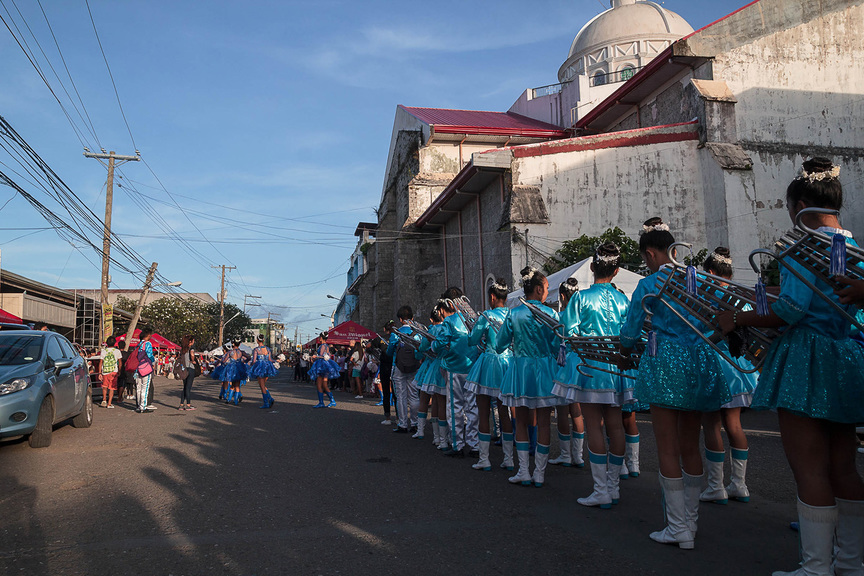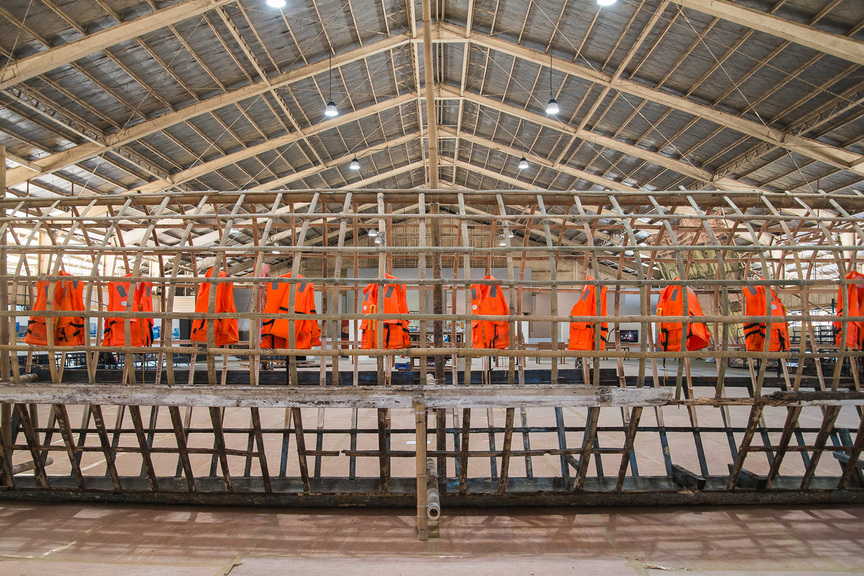
R
E
V N
E
X
T
Installation view of “Don’t Even Bring Water” at the Roxas City Civic Center, VIVA ExCon 2018. Photo by Kiko Nunez. All images courtesy VIVA ExCon 2018 unless otherwise stated.
“As visual artists and cultural workers, we are part of the larger community of people in the region within which VIVA ExCon circulates and connects to. We are not exempt from acting in response to injustice whenever it occurs [. . .] As [practitioners] who engage with the complexity of our contexts, we reiterate our commitment to engaging with platforms such as VIVA ExCon to collectively affirm our solidarity with issues affecting our farmers and the rural sector. We underscore how our continued gathering through VIVA ExCon is a political act, offering a space where these concerns can be collectively raised, weighed and engaged with.”
This was part of the statement that Norberto Roldan—artistic director of the 2018 Visayas Islands Visual Arts Exhibition and Conference (VIVA ExCon)—made during a plenary session, capping off a three-day-long series of conferences. Roldan was alluding to the October 20, 2018, massacre in Sagay City of Negros Occidental province, when nine sugarcane farmers—three men, four women and two children—were murdered by suspected state agents or hired guns of local landlords. The gravity of the subject sobered up the crowd who until then had bore witness to two engrossing discussions on local festivals by researchers Cecile Nava and Christine Muyco, and networks of artist initiatives outside of national capitals featuring artist Katrin de Guia and curators Manuporn Luengaram and Mayumi Hirano.
The keyword in Roldan’s speech was reiterate. VIVA ExCon’s commitment to socio-economic change in the Philippines’ rural provinces can be traced back to the biennial’s inception. VIVA ExCon was initiated in 1990 in Bacolod City, Negros Occidental, by the Black Artists in Asia group, which Roldan co-founded. The event started as an “attempt to bridge the [Visayas] islands” at a time when inter-island travel was difficult. Additionally, the biennial was created “to address specific urgencies of Visayan artists and cultural workers persisting in the shadows of Manila’s cultural imperialism.” Today, it is frequently hailed as the longest-running event of its kind in the country and has since been staged in different parts of the Visayas such as Bacolod, Dumaguete and Cebu.
The 2018 edition marked the first time the festival has been held in Roldan’s hometown of Roxas City in Capiz province. Fittingly, “the aspiration of returning to one’s roots” figured heavily in the festival’s overall curatorial direction with “bisan tubig di magbalon (don’t even bring water),” a line borrowed from the Visayan folk ballad Dandansoy, serving as the curatorial theme. The program handout states: “In the face of limited resources and opportunities, it has been common to desire for the global stage, neglecting in the process one’s place of origin. Each work is a consolatory testament to this economy of means as each artist searches for spaces and semblances of home that require no geographical anchoring.”
The plenitude conveyed by the theme was manifest in the festival’s exhibitions and events. VIVA ExCon 2018 opened on November 8 with performances by avant-pop electronic musician and video artist Joee Mejias with the Capiz State High School marching band, and 100 students from Inzo Arnaldo Village Integrated School with contemporary theater group Sipat X, among others. This was followed by a walking tour of all the exhibition spaces and site-specific projects located around the city plaza.
First was the Civic Center, an indoor basketball court that serves as a multi-purpose hall, which contained the main exhibition along with two open call shows. “Bisan Tubig Di Magbalon (Don’t Even Bring Water)” featured 18 works in total, old and new, spanning a variety of media including paintings, installations, video and sound. Textiles addressing issues of gender and postcolonial identity by Bacolod-based Olive Gloria were displayed with Cristina Taniguchi’s panoramic mural, which depicts lions, Adam and Eve, Pegasus and Michelangelo’s David. Cebu-based collective KLMTW‘s looming, seven-by-eight-meter, soil-on-fabric frottage of a cemetery gate grabbed one’s attention, as did Diokno Pasilan’s readymade of a typhoon-ravaged fishing boat. Paul Pfeiffer’s installation comprising a set of loudspeakers playing a looped sound recording of a basketball game held at the same venue a few weeks prior was hard to miss. Also on display were the various documents, posters and mementos that made up the open-call exhibition “VIVA ExCon Community Archives.” Among such items was Santiago Bose’s sketch for Altar of Pyre (1992/2018), an installation made of materials like bamboo and firewood, which debuted at the 1992 VIVA ExCon and was reconstructed at the Civic Center. Another open call exhibition, “Dagat Kag Dagway (Seascapes and Horizons)” involved 110 participants whose paintings depicting the eponymous scene were exhibited with the horizons aligned, emulating the undulation of waves.
Around the corner from the Civic Center is the official city museum, Ang Panublion Museum. Formerly a water tank, the structure fell into disuse before it was rediscovered and transformed into a museum in 1993. Its circular design was maintained while an annex was constructed. Located in the water tank was “Conjunctions of Meaning and Place,” curated by artist-researcher Liby Limoso. The exhibition brought together objects found in the sites mentioned in the Sugidanun—the oral storytelling tradition of the Panay Bukidnon, an indigenous tribe of Panay island—and recordings such as a 1958 interview with anthropologist Felipe Jocano, as well as a performance by living chanter Leopoldo Caballero. In the annex was “Pagtahud: Lessons from Unsung Luminaries,” an exhibition spotlighting six Capiznon artist-mentors: Lino Villaruz, Ricardo Lauz, Arcadio Apolonario, Nelson Sorillo, Mike Cartujano and Terry Gavino. Curated by Marika Constantino, the show sought to “[pay] tribute to creative expressions coupled with guidance and tutelage.” Beside the museum were several boat installations evoking a fishing port, a performance stage modeled after a sea turtle and a reproduction of a traditional bamboo house, all part of “Balay Sugilanon (Story House)” by Tatsuo Inagaki and around 25 local artists. Functioning as a temporary museum, the bamboo house was installed next to Maricel Café. The eatery’s regulars were interviewed and snippets of these exchanges were exhibited alongside their portraits inside the bamboo house, contributing to the project’s evocation of the old Roxas City.
Across the street is the City Hall where an LED wall was installed on the façade to play Martha Atienza’s Our Islands 11°16’58.4”N 123°45’07.0”E (2017), a video portraying divers performing an Ati-Atihan procession underwater. Similarly, on the Provincial Capitol Building’s façade was Manny Montelibano’s Stress Supplier (2018), which, comprising thermal footage of an urban environment, was almost rejected by Roxas City officials for showing “nudity.” Between the City Hall and a church is the Paseo de Cathedral, a narrow passageway lined with vendors. This was the site of “Abút: Paseo Project,” curated by Mark Salvatus and Philip Sinajonon, which involved multiple interventions and performances including bamboo structures affixed to the Paseo’s nondescript entrance, Ginoe Ojoy’s festive banderitas depicting sundried fish, a mapping project by the Urban Sketchers Capiz and performances from both Mindworks – Island Hopping and the Capiz Mangaka Cosplayers on opening night.
On November 9, “Island Reports,” a regular feature of VIVA ExCon, kicked off the series of conferences held at the Gerry Roxas Training and Convention Center. Eleven delegates from different parts of the Visayas Islands were invited to talk about infrastructural issues and developments in their respective areas to help “[survey] the various art landscapes in the Visayan region.” Other objectives like “assessing successes, strategies and mistakes of cultural platforms in Southeast Asia” were addressed in the succeeding talks that homed in on what happens to communities after festivals, how to make cultural exchanges sustainable and the challenges faced by festival organizers, as well as independent cultural initiatives and the importance of biennials, among other topics.
The post-conference public programs included talks by artist duo Enzo Camacho and Amy Lien, multimedia artists Otty Widasari and Muhammad Sibawaihi, Queer Forever festival director Nguyễn Quốc Thành, a field recording session with Erick Calilan and Paolo Gaiba Riva, and, lastly, a zine-making workshop with Unchalee Anantawat.
VIVA ExCon’s ambition of “[reimagining] the rural as a wellspring of fresh ideas and a source of inspiration for social innovations” and its hopes of “[becoming] a springboard for new collaborations and reciprocal exchanges among local and international art communities with the support of local government units” was undeniably achieved. Judging by the sheer breadth of experiences offered, the engagements VIVA ExCon 2018 prompted and the communities it brought together, one is inclined to agree that the transformation of the Visayas Islands is already underway.
The 2018 VIVA ExCon is on view until January 31, 2019.
To read more of ArtAsiaPacific’s articles, visit our Digital Library.















